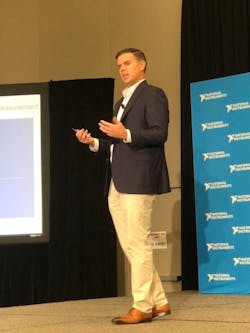The union of the Internet of Things with the emerging 5G wireless network (bringing high-throughput, ultra-availability and low-latency to fixed and mobile devices) will be the catalyst for new industrial applications, especially in automotive, aerospace and semiconductor segments. But the complexity of designing such highly-connected and intelligent systems, coupled with compressed test times and smaller engineering teams, portends a problematic scenario for manufacturers in the very near future.
In an effort to get in front of these megatrends and help design engineers deal with what will inevitably be a highly-customized test development environment, National Instruments (NI) announced a handful of new products at NIWeek in Austin, Texas earlier this week. The standalone software products focus on engineering workflows, allowing engineers to use NI’s flagship product LabView to perform repeated tasks, thereby shortening the automated test and measurement development cycle.
“The new software packages come back to a platform-based approach which is at the center of our DNA,” said Luke Schreier, National Instrument’s vice president of product marketing. “LabView has been around for 32 years, but NI has a different approach to the industry, as our view of software is more about development and empowering people to create, not just consume IP.”
The new products announced this week include:
- FlexLogger configuration-based data-logging software for validation test with integrated data management: Engineers can use FlexLogger to simplify test configurations and extract insights with sensor-specific workflows to acquire and log synchronized mixed measurements with no programming required. This is helpful in areas like electrification and vehicle-to-everything (V2X) communication, which are disrupting how the automotive industry designs, tests and produces vehicles.
- InstrumentStudio software for NI PXI modular instruments: A PXI system includes a chassis that provides power, cooling, and a communication bus for modular instruments or I/O modules. InstrumentStudio evolves the single-instrument soft front panels into a unified, multi-instrument environment so engineers can capture screenshots and measurement results in one view. At different stages in the product design cycle, test engineers often waste time correlating measurements between similar tests that ultimately use different hardware. IntrumentStudio simplifies measurement correlation and aids in the debugging process.
- SystemLink, an application for distributed systems management: SystemLink helps improve operational efficiency and decrease maintenance costs through a centralized interface for automating tasks such as software deployment, remote device configuration and system health performance monitoring.
- Educational Laboratory Virtual Instrumentation Suite (ELVIS) III is a tool for preparing the next-generation of scientists and engineers. ELVIS is a platform designed to meet the specific needs of university engineering education. It combines instrumentation, embedded FPGA design and web-based access to measurements, and curriculum to create a collaborative learning environment in the laboratory, studio and classroom.
The new software portfolio works seamlessly with LabView 2018, also announced this week, as well as the previously announced next-generation LabView NXG, which is still aimed at workflows, but uses different toolsets than the traditional LabView product, and is tailored to some specific use-cases.
New functionality LabView 2018 includes the ability to integrate more third-party IP from tools like Python to make the most of the strengths of each package or existing IP. Test engineers can automate the building and execution of software through integration with open interface tools, like Jenkins, an open source automation server. According to NI, capabilities such as this enables test engineers to focus on system integration and development where they can offer unique differentiation. For test engineers using field programmable gate arrays (FPGA) for high-performance processing, new deep-learning functions and improved floating-point operations can help reduce time-to-market.
Aside from the product announcements, there were demonstrations on the NIWeek exhibit floor that revealed innovations happening at the National Instruments IIoT lab, which opened in January 2017. Since opening the lab, engineers from NI’s partner companies have been working on Time-Sensitive Networking (TSN), a set of IEEE 802 Ethernet sub-standards that prioritize control network traffic over IT network traffic on converged IT/OT Ethernet networks. TSN achieves determinism over standard Ethernet by using time synchronization and a schedule that is shared between network components, ensuring that there is no impact on production systems.
While the TSN technology is ready for industrial environments, it needs infrastructure as every node on the network needs to have built-in TSN capabilities. But many industrial technology suppliers are already rolling out product offerings, including NI.
“NI released multiple products since we first started talking about TSN,” said Brett Burger, NI’s principal solution marketing manager for online monitoring. “We are good at automating measurements and automating workflow, and by building in TSN, as products have measurement problems, our platform can plug in to it.”
There was also a wireless demo that showed how removing the conduit to equipment removes cost. By putting wireless technology onto equipment prone to cause problems, maintenance teams can see potential failures weeks in advance.
In addition, to show off a new Web UI Builder capability for LabView, NI demonstrated how leveraging IoT technology and a tablet mounted on an excavator, data can be sent to the cloud for design engineers to see how products are working in the real world. “It is a fantastic example of how IoT can be leveraged by our platform to make design and testing easier,” Burger said. “And it will eventually map through manufacturing engineering control testing.”

